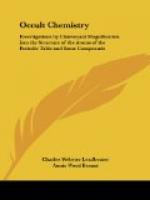2 in each bead, of which there are 110:
7 in each bright spot, of which there
are 10;
2 x 110 + 70 = 290.
When the observers had worked out this, they compared it with the number of ultimate atoms in hydrogen:—
290 / 18 = 16.11 +
The respective number of ultimate atoms contained in a chemical atom of these two bodies are thus seen to closely correspond with their accepted weight-numbers.
It may be said in passing that a chemical atom of ozone appears as an oblate spheroid, with the contained spiral much compressed and widened in the centre; the spiral consists of three snakes, one positive and two negative, formed in a single revolving body. On raising the chemical atom to the next plane, the snake divides into three, each being enclosed in its own egg.
The chemical atom of nitrogen was the third selected by the students for examination, as it seemed comparatively quiet in contrast with the ever-excited oxygen. It proved, however, to be the most complicated of all in its internal arrangements, and its quiet was therefore a little deceptive. Most prominent was the balloon-shaped body in the middle, with six smaller bodies in two horizontal rows and one large egg-shaped one in the midst, contained in it. Some chemical atoms were seen in which the internal arrangement of these contained bodies was changed and the two horizontal rows became vertical; this change seemed to be connected with a greater activity of the whole body, but the observations on this head are too incomplete to be reliable. The balloon-shaped body is positive, and is apparently drawn downwards towards the negative egg-shaped body below it, containing seven smaller particles. In addition to these large bodies, four small ones are seen, two positive and two negative, the positive containing five and the negative four minuter spots.




